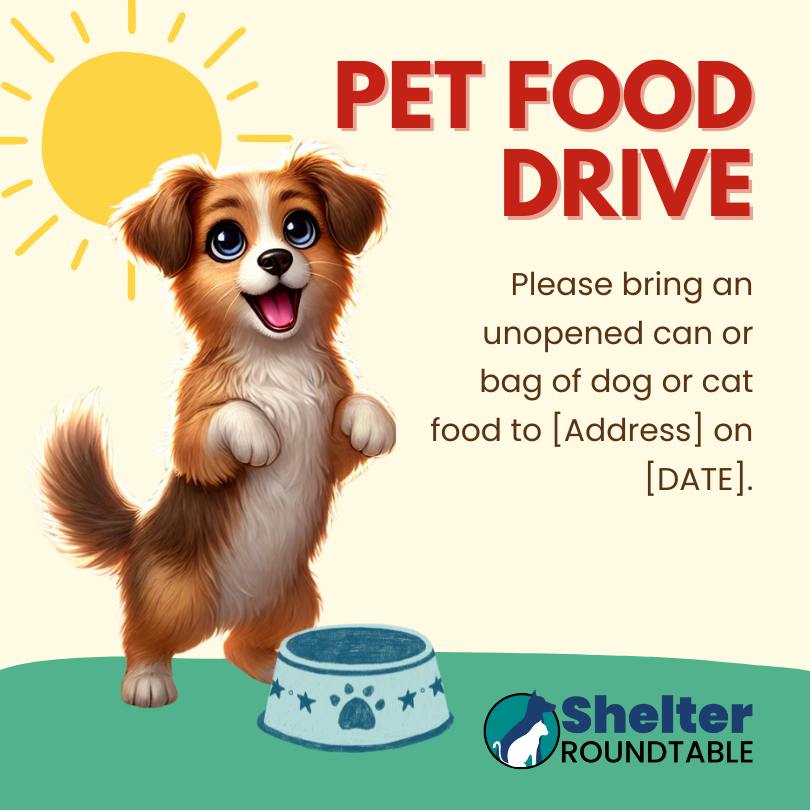Food drives are a terrific way to get the goods you need and make contact. But they can make things harder if you don’t have a clear plan. You might get food that you can’t use, deliveries that come while no one is home, or donations that take a long time to sort. A little planning goes a long way towards having a successful event.
This guide is for shelter managers who wish to run a food drive themselves or help people or businesses that want to run one for them.
Step 1: Decide if You’ll Organize or Support
The first step is deciding who will lead the drive. Will your shelter coordinate it, or will someone else?
If you plan to run the food drive yourself, set a short and manageable time-frame. A one-week or two-week window is best. It creates a sense of urgency for donors and limits how long your team has to manage bins, sorting, and storage. Consider tying your drive to a seasonal event or awareness day. A back-to-school theme, Thanksgiving drive, or summer supply push can help make your message more relevant.
If a local business, school, scout troop, or community member offers to run a drive for you, it helps to have a toolkit ready to share. This might include your wishlist, any restrictions on what can be accepted, branding guidelines if they want to use your logo, and clear drop-off instructions. When a partner handles collection and promotion but works from a clear set of expectations, it saves your team time and helps the drive run more smoothly.
Quick Tips:
- Decide whether your team or a community partner will organize the drive.
- Keep drive timelines short (1–2 weeks works well).
- Tie it to a seasonal theme or awareness event for extra visibility.
- Have a toolkit ready for outside organizers, including wishlist, rules, and contact info.
| Image | Title | Summary | Link |
|---|---|---|---|
 | Pet Food Drive | Help fill empty bowls! Join our Pet Food Drive to ensure every pet has a full belly this season. 🐕🐈 Your donations go a long way in spreading love and… Oh, no! This content requires a higher membership level to view. Not a member? Join for Free Today or Upgrade Your Account to Pro. … | |
 | Feast for Furry Friends | We’re gathering nutritious food and treats to ensure every pet in our care enjoys a special feast. Join us in spreading joy and comfort to these furry… Oh, no! This content requires a higher membership level to view. Not a member? Join for Free Today or Upgrade Your Account to Pro. … |
Step 2: Be Crystal Clear About The Food You Need
Unclear donation requests often result in piles of items your shelter cannot use. A lot of people do not know the difference between adult and puppy food, or they may assume any pet food is good pet food.
Instead of asking for “pet food,” break it down by type: dry dog food, canned cat food, kitten formula, or prescription diets if you accept them. If you have brand preferences due to health or digestive issues, name them. If storage space is limited, specify sizes or limit how much of one item you can accept.
Make sure to clearly list what your shelter can’t accept. This might include opened bags, expired food, food without labels, or treats made overseas. If certain foods or treats are known to cause digestive issues in your animals, explain why they are excluded. Being upfront avoids confusion and saves your team the time of sorting and discarding unusable items later.
Quick Tips:
- Be specific: list exact types and brands of food you need.
- Separate requests by animal type and age (puppy, kitten, senior, etc.).
- Clearly state what you cannot accept and why.
- Mention storage space limits if necessary to prevent overwhelming deliveries.
Step 3: Make It Easy to Give and to Promote Your Food Drive
Food drives work best when they are easy to participate in and simple to promote. Most people are happy to give, but only if they know how and where to do it.
Create a printable flyer that includes your logo, donation drop-off location and hours, specific items needed, and a thank-you message. Add your social media handles or website so people can learn more or stay involved. If you are supporting a third-party drive, offer the flyer as a starting point and encourage them to brand it with their own name or business logo.
Offer a social media graphic with a short caption. For example, “Help fill the food bowl this month! Drop off canned kitten food and dry dog kibble at [Location] between [Dates].” Clear, friendly language goes a long way.
For virtual drives, make sure your Amazon or Chewy wishlist is up to date. Some supporters may prefer to order online and have items shipped directly to you. Include this option on your printed and digital materials.
If you work with local businesses, ask if they will post the flyer in their window, at checkout, or on their Facebook page. Many will be happy to help, especially if it makes them look good to customers and the community.
Quick Tips:
- Provide partners with a ready-to-print flyer and clear instructions.
- Include your drop-off times, location, and preferred items on all materials.
- Share a social media image and caption they can post to spread the word.
- Keep virtual wishlists updated for people who prefer to donate online.
- Ask local businesses to help promote the drive on-site or on social media.
Step 4: Plan for the Food Drive Drop-Off
A successful drive can quickly become a logistical challenge if you are not prepared for the arrival of donations. Boxes might show up when no one is available to accept them, or food could be left outside in the rain or sun.
To prevent this, ask the drive organizer to contact your shelter before they plan to deliver items. A two or three day heads-up allows your team to prepare. You may need to clear space, assign a staff member or volunteer to help unload, and ensure someone is available to thank the donor in person.
If possible, weigh or count the items as they arrive. Knowing how many pounds of food or number of cans were donated gives you data to share in a thank-you post or report. You can also track which types of drives bring in the most usable food, which helps when planning future efforts.
If your storage space is limited, ask in advance whether the donor can stagger their drop-off or hold items until you are ready. Many groups will be flexible, especially if you explain why.
Quick Tips:
- Ask for a 2–3 day heads-up before any large donation drop-off.
- Have a plan for who will receive and process the cans, food bags and other items.
- Track the total weight or count of items collected for future reporting.
- Communicate clearly if you need to delay or stagger deliveries.
Step 5: Thank, Share, and Invite Them Back
Recognition is not just polite. It turns one-time donors into repeat supporters.
Start by sending a thank-you message to the organizer, even if the donation was small. A simple email with a photo or quote about the impact can mean a lot. If the group used social media to promote the drive, tag them in your thank-you post and let your followers know how much their support helped.
Share the results on your own channels. You might post a photo of a dog next to a stack of donated food with a caption like, “Thanks to the community drive at [Business Name], our shelves are full and tails are wagging.” Keep the tone warm, specific, and brief.
If the group or organizer was easy to work with, consider inviting them to do it again. Offer suggestions for next time, such as a toy drive, treats for enrichment, or seasonal items like flea preventatives. Over time, these groups can become reliable partners who understand your needs and want to help in ways that matter.
Quick Tips:
- Always send a thank-you, even for small drives.
- Post on social media to recognize and celebrate the donation.
- Tag the organizer or business if they used social media to help promote.
- Follow up later with ideas for future drives or volunteer opportunities.
What to Watch Out For
Even the best food drives can run into hiccups if a few issues aren’t addressed ahead of time. Here are two areas that deserve a little extra attention:
Legal or Liability Considerations
Before accepting donations from the public, check your local or state regulations around food safety and liability. Some areas prohibit accepting expired food, even if it’s still sealed. Others may require that all donations be unopened and labeled. If your shelter has a written donation policy, include it in any materials shared with potential drive organizers. It protects your organization and helps avoid awkward conversations when items have to be turned away.
Team Roles and Support
Running or receiving a food drive takes coordination, especially if donations come in all at once. Spread the workload by assigning specific roles to staff or volunteers. One person can handle communication with the organizer, another can manage promotion and flyers, and someone else can be in charge of sorting donations or writing thank-you messages. Delegating these tasks ensures things run smoothly without overwhelming any one person—and makes it more likely you’ll want to do it again next time.
Final Tip: Make It Part of the Bigger Picture
A well-organized food drive can introduce your shelter to new supporters, raise awareness , and build lasing relationships. Keep it simple, clear, and donor-friendly, and you’ll end up with more than just food!






0 Comments